List of Indo-European languages
This article has multiple issues. Please help improve it or discuss these issues on the talk page. (Learn how and when to remove these messages)
|



Romance: Germanic:
| Part of a series on |
| Indo-European topics |
|---|
 |
This is a list of languages in the Indo-European language family. It contains a large number of individual languages, together spoken by roughly half the world's population.
Numbers of languages and language groups
[edit]The Indo-European languages include some 449 (SIL estimate, 2018 edition[1]) languages spoken by about 3.5 billion people or more (roughly half of the world population). Most of the major languages belonging to language branches and groups in Europe, and western and southern Asia, belong to the Indo-European language family. This is thus the biggest language family in the world by number of mother tongue speakers (but not by number of languages: by this measure it is only the 3rd or 5th biggest). Eight of the top ten biggest languages, by number of native speakers, are Indo-European. One of these languages, English, is the de facto world lingua franca, with an estimate of over one billion second language speakers. Indo-European language family has 10 known branches or subfamilies, of which eight are living and two are extinct. Most of the subfamilies or linguistic branches in this list contain many subgroups and individual languages. The relationships between these branches (how they are related to one another and branched from the ancestral proto-language) are a matter of further research and not yet fully known. There are some individual Indo-European languages that are unclassified within the language family; they are not yet classified in a branch and could constitute a separate branch. The 449 Indo-European languages identified in the SIL estimate, 2018 edition,[1] are mostly living languages. If all the known extinct Indo-European languages are added, they number more than 800 or close to one thousand. This list includes all known Indo-European languages, living and extinct.
Definition of language
[edit]The distinction between a language and a dialect is not clear-cut and simple: in many areas there is a dialect continuum, with transitional dialects and languages. Further, there is no agreed standard criterion for what amount of differences in vocabulary, grammar, pronunciation and prosody are required to constitute a separate language, as opposed to a mere dialect. Mutual intelligibility can be considered, but there are closely related languages that are also mutual intelligible to some degree, even if it is an asymmetric intelligibility. Or there may be cases where between three dialects, A, B, and C, A and B are mutually intelligible, B and C are mutually intelligible, but A and C are not. In such circumstances grouping the three dielects becomes impossible. Because of this, in this list, several dialect groups and some individual dialects of languages are shown (in italics), especially if a language is or was spoken by a large number of people and over a large land area, but also if it has or had divergent dialects.
Summary of historical development
[edit]The ancestral population and language, Proto-Indo-Europeans that spoke Proto-Indo-European, are estimated to have lived about 4500 BCE (6500 BP). At some point in time, starting about 4000 BCE (6000 BP), this population expanded through migration and cultural influence. This started a complex process of population blend or population replacement, acculturation and language change of peoples in many regions of western and southern Eurasia.[2] This process gave origin to many languages and branches of this language family. By around 1000 BCE, there were many millions of Indo-European speakers, and they lived in a vast geographical area which covered most of western and southern Eurasia (including western Central Asia). In the following two millennia the number of speakers of Indo-European languages increased even further. Indo-European languages continued to be spoken in large land areas, although most of western Central Asia and Asia Minor were lost to other language families (mainly Turkic) due to Turkic expansion, conquests and settlement (after the middle of the first millennium AD and the beginning and middle of the second millennium AD respectively) and also to Mongol invasions and conquests (which changed Central Asia ethnolinguistic composition). Another land area lost to non-Indo-European languages was today's Hungary, due to Magyar/Hungarian (Uralic language speakers) conquest and settlement. However, from about AD 1500 onwards, Indo-European languages expanded their territories to North Asia (Siberia), through Russian expansion, and North America, South America, Australia and New Zealand as the result of the age of European discoveries and European conquests through the expansions of the Portuguese, Spanish, French, English and the Dutch. (These peoples had the biggest continental or maritime empires in the world and their countries were major powers.) The contact between different peoples and languages, especially as a result of European colonization, also gave origin to the many pidgins, creoles and mixed languages that are mainly based in Indo-European languages (many of which are spoken in island groups and coastal regions).
Proto-Indo-European
[edit]- Proto-Indo-European (extinct) (see also Proto-Indo-European homeland)
- Early Proto-Indo-European (First version of Indo-European)
- Middle Proto-Indo-European ("Classical" Indo-European)
- Late Proto-Indo-European (Last version of indo-European as a spoken language before splitting into several languages that originated in the regional dialects that diverged in time, and in space, with Indo-European migrations; these languages were the direct ancestors of today's subfamilies or "branches" of descendant languages) (larger clades of Indo-European than the individual subfamilies or the way individual subfamilies are related to each other are both as-of-yet unresolved issues)
- Middle Proto-Indo-European ("Classical" Indo-European)
- Early Proto-Indo-European (First version of Indo-European)
Dating the split-offs of the main branches
[edit]
Although all Indo-European languages descend from a common ancestor called Proto-Indo-European, the kinship between the subfamilies or branches (large groups of more closely related languages within the language family), that descend from other more recent proto-languages, is not the same because there are subfamilies that are closer or further, and they did not split-off at the same time, the affinity or kinship of Indo-European subfamilies or branches between themselves is still an unresolved and controversial issue and being investigated. However, there is some consensus that Anatolian was the first group of Indo-European (branch) to split-off from all the others and Tocharian was the second in which that happened.[3] Using a mathematical analysis borrowed from evolutionary biology, Donald Ringe and Tandy Warnow propose the following tree of Indo-European branches:[4]
- Proto-Indo-European (PIE)
- Pre-Anatolian (before 3500 BC)
- Pre-Tocharian
- Pre-Italic and Pre-Celtic (before 2500 BC)
- Pre-Armenian and Pre-Greek (after 2500 BC)
- Proto-Indo-Iranian (2000 BC)
- Pre-Germanic and Pre-Balto-Slavic; proto-Germanic (500 BC)
David W. Anthony, following the methodology of Donald Ringe and Tandy Warnow, proposes the following sequence:[4]
- Proto-Indo-European (PIE)
- Pre-Anatolian (4200 BC)
- Pre-Tocharian (3700 BC)
- Pre-Germanic (3300 BC)
- Pre-Italic and Pre-Celtic (3000 BC)
- Pre-Armenian (2800 BC)
- Pre-Balto-Slavic (2800 BC)
- Pre-Greek (2500 BC)
- Proto-Indo-Iranian (2200 BC); split between Old Iranian and Old Indic 1800 BC
The list below follows Donald Ringe, Tandy Warnow and Ann Taylor classification tree for Indo-European branches.[5] quoted in Anthony, David W. (2007), The Horse, the Wheel and Language: How Bronze-Age Riders from the Eurasian Steppes Shaped the Modern World, Princeton University Press.
Anatolian languages (all extinct)
[edit]
- Proto-Anatolian
- Hittite (Nesitic/Central)
- Hittite (Nesite) (𒉈𒅆𒇷 – Nesili)
- Luwic (Southern)
- Western Anatolian?
- Palaic (Northern)
- Unclassified
- Hittite (Nesitic/Central)
Tocharian languages (Agni-Kuči languages) (all extinct)
[edit]
- Proto-Agni-Kuči ("Proto-Tocharian")
- North-Tocharian[11][12][13]
- Agnean (Tocharian A) (also called Turfanian, East Tocharian) (Agni / Ārśi)
- Kuchean (Tocharian B) (also called West Tocharian) (Kuśiññe / Kučiññe)
- South Tocharian
- Kroränian (Tocharian C) (possible)[14] (also called Krorainic, Lolanisch or South Tocharian)
- North-Tocharian[11][12][13]
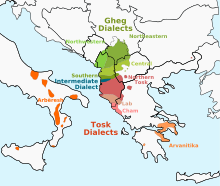
- Proto-Albanian (extinct)
- Albanian (Modern Albanian) (shqip / gjuha shqipe) (dialect continuum)
- Gheg Albanian (gegnisht) (Northern Albanian dialect)
- Arbanasi (Albanian of Zadar, Croatia)
- Istrian Albanian (extinct)
- Upper Reka
- Tosk Albanian (toskërisht) (Southern Albanian dialect, basis of Standard Modern Albanian but not identical)
- Lab
- Cham
- Arbëresh (arbërisht) (Tosk Albanian variety of Southern Italy)
- Arvanitika (Tosk Albanian variety of Central Greece)
- Gheg Albanian (gegnisht) (Northern Albanian dialect)
- Albanian (Modern Albanian) (shqip / gjuha shqipe) (dialect continuum)
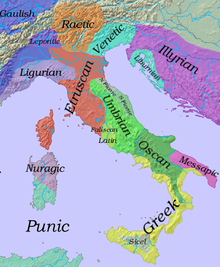


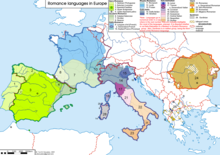
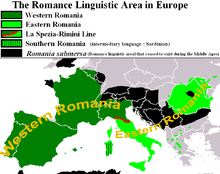
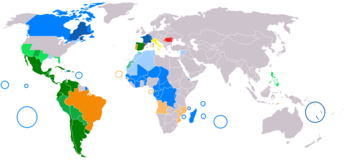
- Proto-Italic (extinct)
- Osco-Umbrian languages (Sabellic languages) (all extinct)
- Umbrian
- Oscan
- Unclassified (within Italic)
- Latino-Faliscan languages
- Faliscan (extinct)
- Latin (Lingua Latina)
- Old Latin (Early Latin / Archaic Latin) (Prisca Latina / Prisca Latinitas) (extinct)
- Classical Latin (LINGVA LATINA – Lingua Latina) (extinct)
- Standard Latin
- Vulgar Latin / Colloquial Latin (sermō vulgāris)
- Lanuvian
- Praenestinian
- British Latin / Britannic Latin (not British Romance) (Latin that was spoken by the Romano-Britons)
- Judeo-Latin (Judæo-Latin)
- Late Latin
- Ecclesiastical Latin (Church Latin, Liturgical Latin) (Lingua Latina Ecclesiastica)
- Medieval Latin
- Hiberno-Latin / Hisperic Latin
- Renaissance Latin
- Neo-Latin or New Latin; (Neolatina or Lingua Latina Nova)
- Contemporary Latin (Latinitas viva)
- Neo-Latin or New Latin; (Neolatina or Lingua Latina Nova)
- Late Vulgar Latin (sermo vulgaris) (Proto-Romance) (extinct)
- Romance (dialect continuum)
- Continental Romance
- Italo-Western languages (dialect continuum)
- Italo-Dalmatian languages (dialect continuum)
- Central Italian (Italiano Centrale)
- Romanesco (Romanesco / Romano)
- Central-Northern Latian / Ciociaro[16]
- Sabino
- Central Marchigiano (Marchigiano Proper)
- Southern Italian
- Neapolitan (Napulitano – O Nnapulitano)
- Molisan[17]
- Campanian
- Beneventano
- Irpino
- Cilentano (Cilentan / Northern Cilentan)
- Apulian
- Castelmezzano
- Northern Calabrian
- Extreme Southern Italian / Far Southern Italian (Siculo-Calabrian)
- Southern Calabrian
- Sicilian / Sicilian Proper (Sicilianu / Lu Sicilianu)
- Cilentano Meridionale (Far Southern Cilentan)
- Salentino (Salentinu)
- Neapolitan (Napulitano – O Nnapulitano)
- Old Tuscan
- Tuscan (Toscano)
- Florentine (Fiorentino)
- Lucchese
- Corsican (Corsu / Lingua Corsa)
- Tuscan (Toscano)
- Venetian (Romance Venetian) (Vèneto / Łéngoa vèneta)
- Triestine
- Fiuman
- Talian
- Chipilo Venetian (Cipilegno)
- Judeo-Italian / Italkian (ג'יודו-איטאליאנו – Giudeo-Italiano / איטלקית – Italqit) (La'az - לעז)
- Judeo-Roman (Giudeo-Romanesco)
- Judeo-Venetian Italkian (Giudeo-Veneziano) (from Venice)
- Judaeo-Piedmontese (Giudeo-Piemontese) (from Piedmont) (extinct)
- Illyro-Roman / Dalmatian (Transitional Western-Eastern Romance)
- Central Italian (Italiano Centrale)
- Western Romance languages (dialect continuum)
- Gallo-Romance languages (dialect continuum)
- Gallo-Italic (Cisalpine Romance)
- Emilian-Romagnol (Emiliân-Rumagnôl, Langua Emiglièna-Rumagnôla)
- Vogherese (Pavese-Vogherese)
- Lombard (Romance Lombard) (Lombard / Lumbaart)
- Eastern Lombard (Lombard)
- Bressano / Bresciano (in Brescia Province)
- Bergamasco (Bergamàsch) (in Bergamo Province)
- Western Lombard (Lombard / Lumbaart)
- Milanese (Milanés) / Meneghin (Macromilanese)
- Brianzöö (Lombardo-prealpino occidentale – macromilanese)
- Bustocco-Legnanese
- Comasco-Lecchese (Lombardo-prealpino occidentale)
- Varesino / Bosin (Lombardo-Prealpino Occidentale)
- Ticinese (Lombardo Alpino)
- Southwestern Lombard (Basso-Lombardo Occidentale)
- Pavese (in Pavia area) (strong influence from Emiliano-Romagnolo language)
- Lodigiano
- Cremunés (in Cremona area) (strong influence from Emiliano-Romagnolo language)
- Spasell (extinct)
- Eastern Lombard (Lombard)
- Novarese (Nuares) (Lombardo-Prealpino Occidentale – Macromilanese)
- Piedmontese (Piemontèis)
- Ligurian (Romance Ligurian) (Ligure / Lengua Ligure / Zeneize)
- Genoese Ligurian (Central Ligurian) (Zeneize)
- Intemelio
- Monégasque (Munegascu)
- Brigasc
- Royasc (Roiasc)
- Intemelio
- Genoese Ligurian (Central Ligurian) (Zeneize)
- Gallo-Italic of Basilicata
- Gallo-Italic of Sicily
- Gallo-Rhaetian
- Rhaeto-Romance
- Oïl (Northern Gallo-Romance) (Langues d'Oïl) (dialect continuum)
- Arpitan (Arpetan / Francoprovençâl / Patouès)
- Valdôtain (Arpitan of Aosta Valley)
- Savoyard
- Vaudois
- Dauphinois
- Lyonnais
- Jurassien (Southern Franc-Comtois)
- Faetar-Cellese (Arpitan of Apulia) (Faetar-Cigliàje)
- Old French (Franceis / François / Romanz) (extinct)
- Middle French (François/Franceis)
- Burgundian-Morvandeau (Bregognon)
- Frainc-Comtois/Jurassien (Frainc-Comtou/Jurassien)
- Francien / Francilien (Île de France Langue d'Oïl)
- French (Français / Langue Française)
- European French
- American French
- Canadian French
- Acadian French (Français Acadien)
- Chiac
- Louisiana French (Cajun French) (Français Louisianais)
- Brayon French
- Québec French (Français Québécois
- Joual
- Ontario French
- New England French (Français de Nouvelle-Angleterre)
- Missouri French / Illinois Country French ("Paw-Paw French")
- Acadian French (Français Acadien)
- Newfoundland French (Français Terre-Neuvien)
- Frenchville French (Français de Frenchville)
- Canadian French
- Saint-Barthélemy French (Patois Saint-Barth)
- Haitian French (Français Haïtien)
- Guianese French
- African French / Sub-Saharan African French (Français Africain)
- Maghreb French / North African French
- Indian French (Français Indien)
- South East Asian French
- Orleanais (Orléanais)
- Blésois
- French (Français / Langue Française)
- Berrichon (Berrichonne)
- Oïl Bourbonnais (Bourbonnais d'Oïl)
- Champenois (Champaignat)
- Lorrain (Lorrain / Gaumais)
- South Norman
- Angevin (Angevin)
- Gallo (Galo)
- Old Norman (Old Romance Norman)
- Norman (Romance Norman) (Normaund)
- Cauchois (spoken in the Pays de Caux)
- Augeron (spoken in the Pays d'Auge)
- Cotentinais (spoken in Cotentin)
- Auregnais / Aoeur'gnaeux (extinct)
- Guernésiais / Dgèrnésiais
- Jèrriais
- Anglo-Norman / Anglo-Norman French (Norman) (extinct)
- Norman (Romance Norman) (Normaund)
- Old Norman (Old Romance Norman)
- Picard (Picard / Chti / Chtimi / Rouchi / Roubaignot)
- Amiénois
- Vermandois
- Thiérache
- Beauvaisis
- "Rouchi" – Tournaisis (Valenciennois)
- Walloon (Walon)
- Poitevin-Saintongeais (Poetevin-Séntunjhaes)
- Poitevin (Poetevin)
- Saintongeais (Saintonjhais)
- Zarphatic (Judaeo-French) (צרפתית – Tzarfatit) (extinct)
- Middle French (François/Franceis)
- Arpitan (Arpetan / Francoprovençâl / Patouès)
- Moselle Romance (extinct)
- Gallo-Italic (Cisalpine Romance)
- British Romance (?) (language of the Romano-Britons or Romanised Britons) (extinct)
- Old Occitan / Old Provençal (Proensals / Proençal / Romans / Lenga d'Òc / Lemosin) (extinct)
- Occitan (Occitan / Lenga d'Òc / Lemosin / Provençal)
- Provençal (Provençau (classical norm) / Prouvençau (mistralian norm))
- Niçard / Nissart
- Shuadit (Judaeo-Provençal / Judaeo-Occitan) (Chouadit) (שואדית – Shuadit) (extinct)
- Niçard / Nissart
- Vivaro-Alpine (Alpine Provençal, Gavòt) (Vivaroalpenc / Vivaroaupenc)
- Auvergnat (Auvernhat)
- Limousin (Lemosin)
- Lengadocian (Northern-Central) (Lengadocian / Lenga d'Oc)
- Provençal (Provençau (classical norm) / Prouvençau (mistralian norm))
- Occitan (Occitan / Lenga d'Òc / Lemosin / Provençal)
- Gascon (Romance Gascon) (Gasco)
- Old Catalan (Catalanesch) (extinct)
- Catalan (Modern Catalan) (Catalan–Valencian–Balearic) (Català / Llengua Catalana)
- Catalanic (Judaeo-Catalan) (קטלאנית יהודית – Judeocatalà / קאטאלנית – Catalànic) (extinct)
- Iberian Romance languages / Hispano-Romance (dialect continuum)[18][18]
- Andalusi Romance (extinct) (dialect continuum)[19]
- Navarro-Aragonese (extinct)
- Aragonese (Aragonés / Luenga Aragonesa / Fabla Aragonesa)
- Eastern Aragonese
- Central Aragonese
- Western Aragonese
- Southern Aragonese
- Judaeo-Aragonese (Chodigo-Aragonés) (extinct)
- Aragonese (Aragonés / Luenga Aragonesa / Fabla Aragonesa)
- Navarro-Aragonese (extinct)
- Western Iberian Romance / Western Hispano-Romance (dialect continuum)
- Castilian (dialect continuum)
- Old Castilian (Romance Castellano) (extinct)
- Spanish / Castilian / Standard Spanish (Español / Castellano / Lengua Española / Lengua Castellana)
- Peninsular Spanish / Spanish of Spain (European Spanish, Spanish of Europe)
- American Spanish / Hispanic American Spanish (Spanish of the Americas)
- Philippine Spanish
- Saharan Spanish
- Equatoguinean Spanish / Equatorial Guinea Spanish
- Castilian Extremaduran (Southern-Central Extremaduran)/ Castúo
- Ladino / Judaeo-Spanish (לאדינו – Ladino / גﬞודﬞיאו־איספאנייול – Djudeo-Espanyol / Judeoespañol)
- Spanish / Castilian / Standard Spanish (Español / Castellano / Lengua Española / Lengua Castellana)
- Cantabrian (Romance Cantabrian) (Cántabru / Montañés)
- Montañés
- Extremaduran (Estremeñu)
- Astur-Leonese (Asturllionés / Astur-Llionés / Llengua Astur-Llionesa) (
- Leonese dialect (Llionés)
- Riudeonore-Guadramil-Deilon-Quintanilha Leonese
- Mirandese (Mirandés / Lhengua Mirandesa)
- Riudeonore-Guadramil-Deilon-Quintanilha Leonese
- Leonese dialect (Llionés)
- Galician–Portuguese (Old Galician–Old Portuguese) (extinct)
- Galician (Galego / Lingua Galega
- Portuguese (Português / Língua Portuguesa)
- Old Castilian (Romance Castellano) (extinct)
- Castilian (dialect continuum)
- Andalusi Romance (extinct) (dialect continuum)[19]
- Gallo-Romance languages (dialect continuum)
- Italo-Dalmatian languages (dialect continuum)
- Eastern Romance languages
- Pannonian Romance (extinct)
- Daco-Roman (dialect continuum)
- Proto-Romanian / Common Romanian
- Aromanian (Rrãmãneshti / Armãneashti / Armãneshce / Limba Rrãmãniascã / Limba Armãneascã / Limba Armãneshce)
- Megleno-Romanian (Vlăhește)
- Old Romanian (Daco-Romanian)
- Modern Romanian (Limba Română / Românește)
- Istro-Romanian (Rumârește / Vlășește)
- Proto-Romanian / Common Romanian
- Italo-Western languages (dialect continuum)
- Southern Romance
- Insular Romance (dialect continuum)
- Sardinian (Sardu or Lingua Sarda / Limba Sarda)
- Logudorese-Nuorese
- Campidanese
- Cagliaritano (Casteddaiu)
- Sardinian (Sardu or Lingua Sarda / Limba Sarda)
- African Romance (extinct)
- Insular Romance (dialect continuum)
- Continental Romance
- Romance (dialect continuum)
- Classical Latin (LINGVA LATINA – Lingua Latina) (extinct)
- Old Latin (Early Latin / Archaic Latin) (Prisca Latina / Prisca Latinitas) (extinct)
- Osco-Umbrian languages (Sabellic languages) (all extinct)


- Proto-Celtic (extinct)
- Continental Celtic (extinct)
- Insular Celtic
- Brittonic / British (P Celtic)
- Common Brittonic / Old Brittonic (extinct)
- Southwestern Brittonic (dialect continuum)
- Old Cornish (extinct)
- Middle Cornish (extinct)
- Cornish (Modern Cornish) (Kernowek)
- Middle Cornish (extinct)
- Old Breton (extinct)
- Middle Breton (extinct)
- Breton (Modern Breton) (Brezhoneg)
- Middle Breton (extinct)
- Old Cornish (extinct)
- Western Brittonic (Dialect continuum)
- Old Welsh (extinct)
- Middle Welsh (extinct)
- Welsh (Modern Welsh) (Cymraeg / y Gymraeg)
- Middle Welsh (extinct)
- Cumbric (extinct)
- Ivernic? (hypothetical) (extinct)
- Old Welsh (extinct)
- Southwestern Brittonic (dialect continuum)
- Pictish (extinct)
- Common Brittonic / Old Brittonic (extinct)
- Goidelic (Q Celtic) (dialect continuum)
- Primitive Irish (extinct)
- Old Irish (Goídelc) (extinct)
- Middle Irish (Gaoidhealg) (extinct)
- Irish (Modern Irish) (Gaeilge) / Irish Gaelic
- Standard Irish (An Caighdeán Oifigiúil)
- Leinster Irish (in Leinster / Laighin) (extinct)
- Connacht Irish (Gaeilge Chonnacht)
- Munster Irish (Gaelainn na Mumhan
- Newfoundland Irish (in Newfoundland) (extinct)
- Ulster Irish (Canúint Uladh) (in Ulster) (Tuaisceartach – Northern)
- Newfoundland Irish (in Newfoundland) (extinct)
- Scottish Gaelic (Gàidhlig) (not to be confused with Scots or Scottish English)
- Mid-Minch Gaelic (Gàidhlig Meadhan na Mara)
- Hebridean / Hebridean Gaelic
- East Sutherland Gaelic (Gàidhlig Chataibh) (extinct)
- Canadian Gaelic / Cape Breton Gaelic
- Galwegian Gaelic (extinct)
- Manx Gaelic (Gaelg / Gailck)
- Northern Manx (Gaelg y Twoaie)
- Douglas Manx (?) (Gaelg y Doolish)
- Southern Manx (Gaelg y Jiass)
- Irish (Modern Irish) (Gaeilge) / Irish Gaelic
- Middle Irish (Gaoidhealg) (extinct)
- Old Irish (Goídelc) (extinct)
- Primitive Irish (extinct)
- Brittonic / British (P Celtic)


- Proto-Greek (extinct)
- Mycenaean Greek (extinct)
- Ancient Greek (Classical Greek) (Ἑλληνική – Hellēnikḗ / Ἑλληνική γλῶσσα – Hellēnikḗ glōssa) (includes Homeric Greek) (extinct) (Dialect continuum)
- Aeolic Greek (extinct)
- Arcadocypriot (extinct)
- Pamphylian Greek (in Pamphylia) (extinct)
- Ionic (extinct)
- Attic (extinct)
- Koine Greek (ἡ κοινὴ διάλεκτος – hē koinḕ diálektos / Kοινὴ – Koinḕ)
- Biblical Greek (Biblical Forms of Koine Greek)
- New Testament Greek (Greek of New Testament)
- Septuagint Greek (Greek of Septuagint (Old Testament))
- Jewish Koine Greek (Greek of Byzantine Jews)
- Medieval Greek (Byzantine Greek / Constantinopolitan Greek)
- Greek (Modern Greek) (ελληνικά – Elliniká) (Dialect continuum)
- Katharevousa (Καθαρεύουσα – Katharevousa)
- Demotic (Δημοτική γλώσσα – Dimotikí glṓssa)
- Southern dialects
- Maniot (in Mani Peninsula) (archaic dialect)
- Himariote
- Cretan
- Cypriot
- Central Greek ("Semi-Northern") (Transitional Southern-Northern Greek)
- Northern dialects
- Southern dialects
- Silliot
- Pharasiot
- Pontic Greek (ποντιακά – Pontiaká)
- Mariupolitan Greek (Rumeíka)
- Pontic Greek (ποντιακά – Pontiaká)
- Cappadocian Greek
- Italiot Greek
- Griko / Salentinian Greek (Γκρίκο – Gríko) (
- Calabrian Greek (Γκραίκο – Graíko)
- Yevanic (Judæo-Greek / Romaniote) (probably extinct)
- Greek (Modern Greek) (ελληνικά – Elliniká) (Dialect continuum)
- Biblical Greek (Biblical Forms of Koine Greek)
- Koine Greek (ἡ κοινὴ διάλεκτος – hē koinḕ diálektos / Kοινὴ – Koinḕ)
- Attic (extinct)
- Doric (extinct)
- Northwest Doric / Northwest Greek (extinct)
- Locrian Greek (in Locris) (extinct)
- Achaean Doric (in Achaea) (North Coast of Peloponnese) (extinct)
- Tsakonian (Tσακώνικα – Tsakṓnika / A Tσακώνικα γρούσσα – A Tsakṓnika gloússa)
- Northwest Doric / Northwest Greek (extinct)
- Ancient Macedonian[21] (extinct)
- Ancient Greek (Classical Greek) (Ἑλληνική – Hellēnikḗ / Ἑλληνική γλῶσσα – Hellēnikḗ glōssa) (includes Homeric Greek) (extinct) (Dialect continuum)
- Mycenaean Greek (extinct)


- Proto-Armenian (extinct)
- Classical Armenian (Old Armenian) (գրաբար հայերէն – Krapar Hayeren / Grabar Hayeren գրաբար – Krapar / Grabar) (Classical language, High culture language, official language of the Armenian Kingdom, liturgical or sacred language of the Armenian Apostolic Church and the Armenian Catholic Church)
- Liturgical Armenian
- Middle Armenian
- Judeo-Armenian
- Armenian (Modern Armenian) (հայերէն]] or հայերեն – Hayeren) (dialect continuum)
- Western Armenian (արեւմտահայերէն – Arevmdahayerēn) (dialect continuum)
- Karin / Upper Armenia (Bardzr Hayk')
- Kharpert-Yerznka (Tsopk') (nearly extinct)
- Nikopoli Armenian
- Homshetsi
- Eastern Armenian (արևելահայերեն – Arevelahayeren) (dialect continuum)
- Western Armenian (արեւմտահայերէն – Arevmdahayerēn) (dialect continuum)
- Classical Armenian (Old Armenian) (գրաբար հայերէն – Krapar Hayeren / Grabar Hayeren գրաբար – Krapar / Grabar) (Classical language, High culture language, official language of the Armenian Kingdom, liturgical or sacred language of the Armenian Apostolic Church and the Armenian Catholic Church)
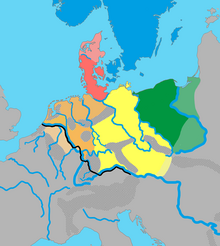
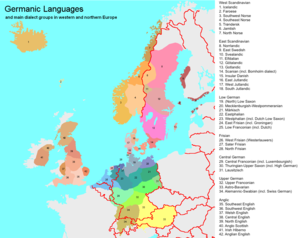

- Proto-Germanic (extinct)
- East Germanic / Oder-Vistula Germanic
- Northwest Germanic
- West Germanic
- Elbe Germanic
- Langobardic / Lombardic (extinct)
- Suebian (extinct) [25]
- High German languages
- Old High German
- Middle High German
- Early New High German
- New High German
- Central German / Middle German
- Standard German
- Upper German
- East Franconian
- South Franconian (Südfränkisch)
- Swabian-Alemannic
- Bavarian / Austro-Bavarian
- Northern Bavarian / North Bavarian
- Central Bavarian
- Southern Bavarian
- New High German
- Early New High German
- Middle High German
- Old High German
- High German languages
- Weser–Rhine Germanic
- Low Franconian languages
- Old Low Franconian
- Limburgish
- West Low Franconian / North Low Franconian
- Old Low Franconian
- North Sea Germanic
- Old Low German
- Anglo-Frisian languages
- Anglic languages
- Old English (extinct)
- Northumbrian
- Middle English (extinct)
- Northumbrian
- Early Scots (extinct)
- Middle Scots (extinct)
- Scots (mainly Brittonic languages and also Scottish Gaelic substrates in the Scottish Lowlands and mainly Scottish Gaelic substrate in the Scottish Highlands)
- Middle Scots (extinct)
- Kentish
- Fingallian (extinct)
- Yola (extinct)
- Early Scots (extinct)
- Early Modern English
- Modern English
- English
- Standard English
- North American English
- Caribbean English
- South Atlantic English
- Falkland Islands English
- Australian English
- New Zealand English
- Solomon Islands English
- Fiji English
- South African English
- Namlish
- Gibraltarian English
- Yeshivish
- Pakistani English
- Nepalese English
- General Indian English
- Bangladeshi English
- Burmese / Myanmar English
- Thai English
- Malaysian English
- Manglish
- Singapore English
- Singlish
- Brunei English
- Philippine English
- Palauan English
- Hong Kong English
- Gambian English
- Liberian English
- Ghanaian English
- Nigerian English
- Cameroonian English
- Malawian English
- Ugandan English
- Kenyan English
- English
- Modern English
- Northumbrian
- Frisian languages
- Old English (extinct)
- Anglic languages
- Elbe Germanic
- West Germanic
- North Germanic
- Proto-Norse/Proto-Scandinavian (extinct)
- Old Norse (extinct)
- Old Gutnish (extinct)
- East Scandinavian
- Old East Norse (extinct)
- Old Swedish (extinct)
- Old Danish (extinct)
- Dalecarlian / Dalarna dialect
- Jamtlandic
- Old East Norse (extinct)
- West Scandinavian
- Old West Norse (extinct)
- Old Norwegian (extinct)
- Middle Norwegian (extinct)
- Old Norwegian (extinct)
- Old West Norse (extinct)
- Old Norse (extinct)
- Proto-Norse/Proto-Scandinavian (extinct)
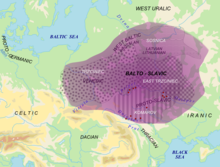




- Proto-Balto-Slavic (extinct)
- Proto-Baltic (extinct)
- Eastern Baltic
- East Galindian (extinct)
- Old Latvian (extinct)
- Latvian
- Selonian (extinct)
- Semigallian (extinct)
- Old Lithuanian (extinct)
- Lithuanian
- Highland Lithuanian / Aukštaitian
- Lowland Lithuanian / Samogitian
- Lithuanian
- Curonian (extinct)
- Western Baltic
- Old Prussian / Baltic Prussian (extinct)
- Skalvian (extinct)
- West Galindian (extinct)
- Sudovian (extinct)
- Eastern Baltic
- Proto-Slavic (extinct)
- East Slavic languages
- Old Novgorodian (extinct)
- Old East Slavic (extinct)
- Ruthenian (extinct)
- Rusyn / Carpathian Rusyn
- Pannonian Rusyn / Bačka Rusyn
- Ukrainian
- Belarusian
- Russian
- Rusyn / Carpathian Rusyn
- Ruthenian (extinct)
- Old East Slavic (extinct)
- Old Novgorodian (extinct)
- West Slavic languages
- Lechitic
- Old Polish (extinct)
- Pomeranian
- Kashubian
- Slovincian (extinct)
- Polabian (extinct)
- Sorbian
- Silesian
- Czech-Slovak
- Lechitic
- South Slavic languages
- Western South Slavic
- Eastern South Slavic /
- Old Church Slavonic (extinct)
- Bulgarian-Macedonian
- Bulgarian
- Western Bulgarian
- Eastern Bulgarian
- Macedonian
- Kumanovo dialect
- Kriva Palanka dialect
- Skopska Crna Gora dialect
- Tetovo dialect
- Maleševo-Pirin dialect
- Štip-Kočani dialect
- Strumica dialect
- Ser-Drama-Lagadin-Nevrokop dialect
- Solun-Voden dialect
- Kostur dialect
- Nestram-Kostenar dialect
- Prilep-Bitola dialect
- Kičevo-Poreče dialect
- Skopje-Veles dialect
- Lower Prespa dialect
- Upper Prespa dialect
- Ohrid dialect
- Struga dialect
- Vevčani-Radožda dialect
- Debar dialect
- Galičnik dialect
- Reka dialect
- Gostivar dialect
- Spoken Macedonian
- Bulgarian
- East Slavic languages
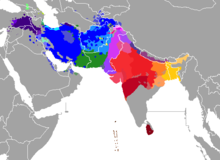
- Proto-Indo-Iranian (extinct)


- Proto-Iranian
- Eastern Iranian languages
- Northeastern Iranian languages
- Old Northeast Iranian
- Scytho-Sarmatian
- Scythian (extinct)
- Sarmatian (extinct)
- Alanic (extinct)
- Ossetian
- Iron Ossetian
- Digor Ossetian
- Jassic (extinct)
- Ossetian
- Alanic (extinct)
- Scytho-Khotanese (extinct)
- Tumshuqese (extinct)
- Kanchaki (extinct)
- Khotanese (extinct)[32]
- Khwarazmian / Chorasmian[33] (extinct)
- Sogdian (extinct)
- Scytho-Sarmatian
- Southeastern Iranian languages
- Old Southeast Iranian
- Avestan (extinct)
- Old Avestan / "Gathic Avestan"[34] (extinct)
- Avestan (extinct)
- Old Southeast Iranian
- Young Avestan / Younger Avestan (extinct)[35][36] (extinct)
- Bactrian (extinct)[37]
- Munji
- Yidgha
- Sarghulami (extinct)
- Rushani
- Oroshori
- Shughni / Khughni
- Khufi
- Bartangi
- Sarikoli / Tashkorghani
- Sanglechi-Ishkashimi / Zebaki[38]
- Wakhi [38]
- Ormuri-Parachi
- Ormuri
- Parachi
- Old Pakhto
- Pakhto / Pashto / Pathan
- Northern Pashto
- Northern dialect
- Yusufzai dialect
- Southern Pashto
- Durrani dialect
- Northern Pashto
- Wanetsi
- Pakhto / Pashto / Pathan
- Bactrian (extinct)[37]
- Old Northeast Iranian
- Northeastern Iranian languages
- Western Iranian languages
- Northwestern Iranian languages / Northern Western Iranian
- Median / Medic (extinct)
- Kurdish
- Zaza-Gorani
- Old Azeri (extinct)
- Talysh
- Gozarkhani
- Kajali
- Koresh-e Rostam
- Maraghei
- Razajerdi
- Shahrudi
- Ashtiani
- Vafsi
- Alviri-Vidari
- Judeo-Hamadani
- Khunsari
- Judeo-Golpaygani (extinct)
- Gazi
- Jarquya’i
- Abuzaydabadi
- Soi / Sohi
- Natanzi
- Judeo-Kashani
- Zoroastrian Dari
- Nayini / Na'ini / Biyabanak
- Khuri
- Balochi
- Parthian (extinct)
- Median / Medic (extinct)
- Southwestern Iranian languages/Southern Western Iranian
- Old Persian (𐎠𐎼𐎹 – Ariya) (extinct)
- Middle Persian (𐭯𐭠𐭫𐭮𐭩𐭪 – Pārsīk or Pārsīg) (extinct)
- Persian
- Iranian Persian
- Afghanistan Persian / Dari Persian
- Afghanistan Persian
- Pahlavni / Pahlavani (extinct)
- Aimaq / Aimaqi / Aimaq Persian
- Hazaragi / Hazaragi Persian
- Tajik / Tajiki Persian
- Tat / Caucasus Tat / Persian Tat
- Muslim/Christian Tat
- Judeo-Tat / Judeo-Persian Tat
- Kuhmareyi
- Luri
- Southern Luri
- Northern Luri / Central Luri
- Bakhtiari
- Khuzestani Persian
- Lari
- Garmsiri
- Bashkardi / Bashagerdi / Bashaka
- Kumzari
- Persian
- Middle Persian (𐭯𐭠𐭫𐭮𐭩𐭪 – Pārsīk or Pārsīg) (extinct)
- Old Persian (𐎠𐎼𐎹 – Ariya) (extinct)
- Northwestern Iranian languages / Northern Western Iranian
- Eastern Iranian languages


- Proto-Nuristani (extinct) [39][40]


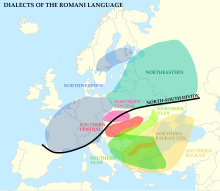
- Proto-Indo-Aryan (extinct)
- Old Indo-Aryan (extinct)
- Mitanni-Aryan
- Early Old Indo-Aryan – Vedic Sanskrit / Rigvedic Sanskrit
- Late Old Indo-Aryan – Sanskrit
- Middle Indo-Aryan (extinct)
- Dardic
- Gandhari Prakrit (extinct)
- Niya Prakrit[14][41] / Kroraina Prakrit / Niya Gāndhārī (extinct)
- Chitral languages
- Kashmiri / Koshur
- Kohistani languages
- Pashayi / Pashai
- Kunar languages
- Dameli
- Gawar-Bati / Narsati / Aranduyiwar
- Nangalami / Grangali
- Shumashti
- Shina languages
- Gandhari Prakrit (extinct)
- North-Western Indo-Aryan
- Punjabi languages
- Sindhi languages
- Northern Indo-Aryan
- Western Indo-Aryan
- Gurjar apabhraṃśa
- Rajasthani
- Gujarati
- Old Gujarati (extinct)
- Jandavra / Jhandoria
- Vaghri / Waghri / Baghri
- Aer
- Sauraseni Prakrit (extinct)
- Vasavi / Vasavi Bhil
- Bhil
- Khandeshi
- Domari-Romani
- Domari
- Seb Seliyer
- Romani
- Balkan Romani
- Sepečides Romani
- Vlax Romani
- Northern Romani
- Carpathian Romani
- Romungro / Romungro Romani
- Roman / Roman Romani
- Vend / Vend Romani
- East Slovak Romani
- West Slovak Romani
- South Polish Romani
- Sinte Romani (Sintenghero / Tschib(en) / Sintitikes / Manuš / Romanes)
- Welsh-Romani
- Baltic Romani
- Carpathian Romani
- Gurjar apabhraṃśa
- Central Indo-Aryan
- Sauraseni Prakrit (extinct)
- Western Hindi
- Parya
- Ardhamagadhi Prakrit (extinct)
- Awadhi
- Bagheli
- Surgujia / Sargujia / Surgujia Chhattisgarhi / Bhandar
- Chhattisgarhi
- Sauraseni Prakrit (extinct)
- Eastern Indo-Aryan
- Magadhi Prakrit (extinct)
- Pali (extinct)
- Apabhramsa Avahatta / Abahattha (extinct)
- Bihari languages
- Bhojpuri
- Mauritian Bhojpuri
- Caribbean Hindustani
- Guyanese Hindustani
- Sarnami Hindustani / Sarnami Hindoestani
- Magahi / Magadhi
- Khortha
- Maithili
- Kudmali / Kurmali / Panchpargania / Tamaria (কুর্মালী]] – কুড়মালি]] – Kur(a)mālī)
- Musasa
- Sadri / Sadani / Nagpuri
- Oraon Sadri
- Bhojpuri
- Bengali-Assamese languages
- Bengali
- Varendri
- Rarhi
- Manbhumi
- Bangali / Vangi
- Dhakaiya Kutti or Puran Dhakaiya
- Noakhailla
- Sylheti
- Chittagonian / Chattal
- Rohingya
- Kurmukar
- Bishnupriya Manipuri
- Chakma
- Tangchangya
- Hajong
- Kharia Thar
- Lodhi (?)
- Bengali
- Kamarupi Prakrit / Kamrupi Apabhramsa (extinct)
- Surjapuri / Surajpuri
- Rangpuriya / Rangpuri / Rajbanshi / Rajbangsi / Kamtapuri / Deshi Bhasha / Uzani
- Old Assamese
- Odia languages
- Old Odia
- Odia proper
- Adivasi Oriya / Adivasi Odia
- Bodo Parja / Jharia
- Sambalpuri / Western Odia
- Reli / Relli
- Kupia
- Old Odia
- Bihari languages
- Apabhramsa Avahatta / Abahattha (extinct)
- Halbic
- Southern Indo-Aryan
- Maharashtri Prakrit (extinct)
- Dardic
- Middle Indo-Aryan (extinct)
- Late Old Indo-Aryan – Sanskrit
- Old Indo-Aryan (extinct)
Unclassified Indo-European languages (all extinct)
[edit]Indo-European languages whose relationship to other languages in the family is unclear
- Brygian
- Phrygian
- Moesian
- Mysian?
- Mushkian
- Mygdonian?
- Paionian
- Belgic/Ancient Belgian
- Cimmerian
- Dardanian
- Assinean
- Gushiean
- Ligurian
- Lusitanian
- Daco-Thracian
- Illyrian language
- Messapic
- Venetic
- Liburnian
Possible Indo-European languages (all extinct)
[edit]Unclassified languages that may have been Indo-European or members of other language families (?)
See also
[edit]- List of Pidgins, Creoles, Mixed languages and Cants based on Indo-European languages
- Proto-Human
- Borean languages
- Nostratic
- Eurasiatic
- Uralo-Siberian
- Indo-Uralic
- Indo-Anatolian (Indo-Hittite)
- Paleo-Balkan
- Daco-Thracian
- Graeco-Armenian
- Graeco-Aryan
- Graeco-Phrygian
- Thraco-Illyrian
- Italo-Celtic
References
[edit]- ^ a b "Ethnologue report for Indo-European". Ethnologue.com. Archived from the original on 2012-01-06. Retrieved 2012-12-07.
- ^ Allentoft, Morten E.; Sikora, Martin; Sjögren, Karl-Göran; Rasmussen, Simon; Rasmussen, Morten; Stenderup, Jesper; Damgaard, Peter B.; Schroeder, Hannes; Ahlström, Torbjörn; Vinner, Lasse; Malaspinas, Anna-Sapfo; Margaryan, Ashot; Higham, Tom; Chivall, David; Lynnerup, Niels; Harvig, Lise; Baron, Justyna; Casa, Philippe Della; Dąbrowski, Paweł; Duffy, Paul R.; Ebel, Alexander V.; Epimakhov, Andrey; Frei, Karin; Furmanek, Mirosław; Gralak, Tomasz; Gromov, Andrey; Gronkiewicz, Stanisław; Grupe, Gisela; Hajdu, Tamás; et al. (2015). "Population genomics of Bronze Age Eurasia". Nature. 522 (7555): 167–172. Bibcode:2015Natur.522..167A. doi:10.1038/nature14507. PMID 26062507. S2CID 4399103. Archived from the original on 2019-03-29. Retrieved 2018-11-04.
- ^ KAPOVIĆ, Mate. (ed.) (2017). The Indo-European Languages. ISBN 978-0-367-86902-1
- ^ a b Anthony, David W. (2007), The Horse, the Wheel and Language: How Bronze-Age Riders from the Eurasian Steppes Shaped the Modern World, Princeton University Press
- ^ Ringe, Don; Warnow, Tandy.; Taylor, Ann. (2002). 'Indo-European and Computational Cladistics', Transactions of the Philological Society, n.º 100/1, 59-129.
- ^ "New Indo-European Language Discovered". Archived from the original on 2023-09-26. Retrieved 2023-09-26.
- ^ "Kalasmaic, a New IE Language". Archived from the original on 2023-09-26. Retrieved 2023-09-26.
- ^ "A new Indo-European Language discovered in the Hittite capital Hattusa". Archived from the original on 2023-09-26. Retrieved 2023-09-26.
- ^ "New Indo-European Language Discovered in Ancient City of Hattusa". Archived from the original on 2023-09-26. Retrieved 2023-09-26.
- ^ Mallory, J.P.; Mair, Victor H. (2000), The Tarim Mummies, London: Thames & Hudson, pp. 67, 68, 274, ISBN 0-500-05101-1.
- ^ Krause, Todd B.; Slocum, Jonathan. "Tocharian Online: Series Introduction". University of Texas at Austin. Retrieved 17 April 2020.
- ^ Beckwith, Christopher I. (2009), Empires of the Silk Road: A History of Central Asia from the Bronze Age to the Present, Princeton University Press, ISBN 978-0-691-15034-5.
- ^ Voynikov, Zhivko. (?). Some ancient Chinese names in East Turkestan and Central Asia and the Tocharian question.
- ^ a b "Niya Tocharian: language contact and prehistory on the Silk Road". cordis.europa.eu. Archived from the original on 2023-01-27. Retrieved 2023-01-05.
- ^ Bereznay, András (2011). Erdély történetének atlasza [Atlas of the History of Transylvania] (in Hungarian). Méry Ratio. p. 63. ISBN 978-80-89286-45-4.
- ^ Pellegrini G., Carta dei dialetti d'Italia, CNR – Pacini ed., Pisa, 1977
- ^ a b Vignuzzi 1997: 312, 317; Loporcaro & Panciani 2016: 229, 233
- ^ a b Menéndez Pidal, Ramón. (2005). Historia de la Lengua Española (2 Vols.). Madrid: Fundación Ramón Menendez Pidal. ISBN 84-89934-11-8
- ^ Marcos Marín, Francisco. (1998). "Romance andalusí y mozárabe: dos términos no sinónimos", Estudios de Lingüística y Filología Españolas. Homenaje a Germán Colón. Madrid: Gredos, 335–341. https://www.academia.edu/5101871/Romance_andalusi_y_mozarabe_dos_terminos_no_sinonimos_ Archived 2022-01-07 at the Wayback Machine
- ^ Dawkins, R.M. 1916. Modern Greek in Asia Minor. A study of dialect of Silly, Cappadocia and Pharasa. Cambridge: Cambridge University Press.
- ^ "Ancient Macedonian". MultiTree: A Digital Library of Language Relationships. Archived from the original on November 22, 2013. Retrieved 28 March 2016.
- ^ a b "Gothic language | Origins, History & Vocabulary | Britannica". www.britannica.com. 25 September 2023. Archived from the original on 21 December 2018. Retrieved 18 August 2023.
- ^ "East Germanic languages | History, Characteristics & Dialects | Britannica". www.britannica.com. Archived from the original on 2023-08-18. Retrieved 2023-08-18.
- ^ MacDonald Stearns, Das Krimgotische. In: Heinrich Beck (ed.), Germanische Rest- und Trümmersprachen, Berlin/New York 1989, p. 175–194, here the chapter Die Dialektzugehörigkeit des Krimgotischen on p. 181–185
- ^ Harm, Volker , "Elbgermanisch", "Weser-Rhein-Germanisch" und die Grundlagen des Althochdeutschen, in Nielsen; Stiles (eds.), Unity and Diversity in West Germanic and the Emergence of English, German, Frisian and Dutch, North-Western European Language Evolution, vol. 66, pp. 79–99
- ^ C. A. M. Noble: Modern German Dialects. Peter Lang, New York / Berne / Frankfort on the Main, p. 131
- ^ a b Instituut voor de Nederlandse Taal: De Geïntegreerde Taal-Bank:
Woordenboek der Nederlandsche Taal , entry VlamingI Archived 2023-10-05 at the Wayback Machine;
cp.: Oudnederlands Woordenboek , entry flāmink Archived 2023-10-05 at the Wayback Machine: "Morfologie: afleiding, basiswoord : flāma ‘overstroomd gebied’; suffix: ink ‘vormt afstammingsnamen’"; Vroegmiddelnederlands Woordenboek , entry Vlaendren Archived 2023-10-05 at the Wayback Machine: "Etymologie: Dat.pl. van flandr- 'overstroomd gebied' met het suffix -dr-.".
Cognate to Middle English flēm 'current of a stream': Middle English Compendium → Middle English Dictionary : flēm n.(2) Archived 2023-12-09 at the Wayback Machine - ^ Oxford English Dictionary, "Holland, n. 1," etymology.
- ^ Hendricks, Frank . "The nature and context of Kaaps: a contemporary, past and future perspective".[1] Archived 2022-10-23 at the Wayback Machine Multilingual Margins: A Journal of Multilingualism from the Periphery. 3 (2): 6–39. doi:10.14426/mm.v3i2.38. ISSN 2221-4216. S2CID 197552885.
- ^ "The medieval 'New England': A forgotten Anglo-Saxon colony on the north-eastern Black Sea coast" https://www.caitlingreen.org/2015/05/medieval-new-england-black-sea.html Archived 2023-08-18 at the Wayback Machine
- ^ Simpson, St John (2017). "The Scythians. Discovering the Nomad-Warriors of Siberia". Current World Archaeology. 84: 16–21. "nomadic people made up of many different tribes thrived across a vast region that stretched from the borders of northern China and Mongolia, through southern Siberia and northern Kazakhstan, as far as the northern reaches of the Black Sea. Collectively they were known by their Greek name: the Scythians. They spoke Iranian languages..."
- ^ ""Unknown Kushan Script" Partially Deciphered - Archaeology Magazine". Archived from the original on 2023-09-26. Retrieved 2023-09-26.
- ^ "Welcome to Encyclopaedia Iranica". Archived from the original on 2020-11-12. Retrieved 2023-10-05.
- ^ "The Avestan texts contain no historical allusions and can therefore not be dated exactly, but Old Avestan is a language closely akin to the oldest Indic language, used in the oldest parts of the Rigveda, and should therefore probably be dated to about the same time. This date is also somewhat debated, though within a relatively small time span, and it seems probable that the oldest Vedic poems were composed over several centuries around the middle of the 2nd millennium B.C.E. (see, e.g., Witzel, 1995)", quoted in https://iranicaonline.org/articles/iran-vi1-earliest-evidence Archived 2023-09-21 at the Wayback Machine
- ^ "Young Avestan is grammatically close to Old Persian, which ceased being spoken in the 5th-4th centuries B.C.E. These two languages were therefore probably spoken throughout the first half of the first millennium B.C.E. (see, e.g., Skjærvø, 2003-04, with further references)." in https://iranicaonline.org/articles/iran-vi1-earliest-evidence Archived 2023-09-21 at the Wayback Machine
- ^ The Young Avesta contains a few geographical names, all belonging to roughly the area between Chorasmia and the Helmand, that is, the modern Central Asian republics and Afghanistan (see, e.g., Skjærvø, 1995; Witzel, 2000). We are therefore entitled to conclude that Young Avestan reflects the language spoken primarily by tribes from that area. The dialect position of the language also indicates that the language of the Avesta must have belonged to, or at least have been transmitted by, tribes from northeastern Iran (the change of proto-Iranian *-āḭā/ă- > *-ayā/ă- and *ǰīwa- > *ǰuwa- “live,” for instance, is typical of Sogdian, Khotanese, Pashto, etc. in https://iranicaonline.org/articles/iran-vi1-earliest-evidence Archived 2023-09-21 at the Wayback Machine).
- ^ It was long thought that Avestan represented "Old Bactrian", but this notion had "rightly fallen into discredit by the end of the 19th century", in Gershevitch, Ilya (1983), "Bactrian Literature", in Yarshater, Ehsan (ed.), Cambridge History of Iran, vol. 3, Cambridge: Cambridge UP, pp. 1250–1258, ISBN 0-511-46773-7.
- ^ a b Antje Wendtland (2009), The position of the Pamir languages within East Iranian, Orientalia Suecana LVIII "The Pamir languages are a group of East Iranian languages which are linguistically quite diverse and cannot be traced back to a common ancestor. The term Pamir languages is based on their geographical position rather than on their genetic closeness. Exclusive features by which the Pamir languages can be distinguished from all other East Iranian languages cannot be found either."
- ^ See also: Ancient Kamboja, People & the Country, 1981, p 278, These Kamboj People, 1979, pp 119–20, K. S. Dardi etc.
- ^ Sir Thomas H. Holdich, in his classic book, (The Gates of India, p 102-03), writes that the Aspasians (Aspasioi) represent the modern Kafirs. But the modern Kafirs, especially the Siah-Posh Kafirs (Kamoz/Camoje, Kamtoz) etc are considered to be modern representatives of the ancient Kambojas.
- ^ Burrow, T. (1936). "The Dialectical Position of the Niya Prakrit". Bulletin of the School of Oriental Studies, University of London. 8 (2/3): 419–435. doi:10.1017/S0041977X00141060. JSTOR 608051. S2CID 170991822. Archived from the original on 2023-07-19. Retrieved 2021-04-25.
